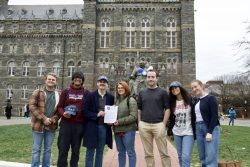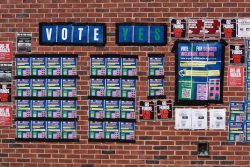Earlier this month, Georgetown’s club sports athletes started a petition to Georgetown University Student Association’s Finance and Appropriations Committee calling for them provide a stable source of funding for their athletic training program. They believe that the Advisory Board for Club Sports cannot support the program with its reserve account. They request help from GUSA to provide a sustainable source of funding.
All university-recognized club sports organizations have access to Katharine Gray, the sole athletic trainer at the Center for Student Engagement, albeit through a tiered system. She is only available at practices and competitions of club sports that are categorized as “high-risk,” which are men’s and women’s rugby, boxing, and ice hockey. Other club sports must request access to her services through an application-based process. Women’s basketball and the triathlon team are among the groups that have successfully done so.
GUSA’s FinApp committee should support the petition. An advisory board’s reserve funds help contribute to larger expenditures and shoulder deficits incurred by the accounts of individual student organizations. Club sports cannot be expected to withdraw from their reserve funds simply to ensure that teams have the ability to treat and avoid injuries.
Currently, varsity athletes have access to 10 athletic trainers, who work with four physicians, compared to only one trainer for the club teams. This disparity is unacceptable. Club sports athletes are Georgetown’s representatives wherever they compete. Their injuries are no less serious than varisty athletes’ injuries. They deserve nothing less than an equal access to medical treatment.
A lack of funding for more athletic trainers is only part of the problem. Allocating access to trainers based on the likelihood that a sport will cause an injury is efficient, but a serious injury in a “high-tier” sport is no more damaging than a serious injury in a “low-tier” sport. All teams should be able to receive a trainer’s help as soon as possible. More money would afford the club sports program the flexibility they need to remove the tiered system.
Club sports are a major facet of Georgetown’s recreational life. In Dec. 2014, the campus had 1,142 club sports participants—just over one sixth of the undergraduate student body—in over 31 teams. Yet, the university administration has a long track record of providing insufficient support to club sports. The lack of suitable practice space for club athletes and the continual deterioration of Kehoe Field—despite years of nearly universal support for the field’s renovation—is the best example of that fact.
Requesting funds from GUSA’s FinApp committee is nonetheless a small-scale fix for what is a much larger problem. Some students may balk at the petition, since FinApp would have to draw money from GUSA’s budget or from the Student Activities Fee, diluting the remaining funds available for other GUSA initiatives or student organizations in other advisory boards.
Ultimately, GUSA should not have to bear the brunt of the club sports funding request. Rather, the university itself should be responsible for giving its club sports the support they need.




